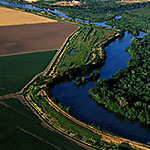Restore the Delta put out two clever pieces yesterday by stating “Pinocchio” on items within the Bay Delta Conservation Plan (BDCP) and correcting its claims. I wanted to pass along the reads to you as they are not very long reads but get the points across.
The articles include:
- Pinocchio Item 1: BDCP will eliminate export fish kills
- Pinocchio Item 2: BDCP will benefit the regional economy by creating jobs
Restore the Delta claims the BDCP plan of peripheral tunnels plan does nothing to reduce fish kills and will actually increase the kills. Meanwhile, the group also claims jobs are “costs” and not “benefits”. They highlight that jobs from this project are not permanent and the region will lose 28,000 agricultural jobs.
Here are the articles:
Pinocchio Item 1: BDCP will eliminate export fish kills
Last month, DWR director Mark Cowin announced that computer modeling showed an additional 700,000 acre-feet of water could have been sent to exporters since November 1 if the peripheral tunnels had been in place. The argument is that with North Delta diversions, less water would be pumped from the South Delta, so smelt would not be harmed and pumping would not be restricted.
That’s nonsense, according to Bill Jennings, Executive Director of the California Sportfishing Protection Alliance. Jennings has produced a white paper showing why the peripheral tunnels being advocated by BDCP will NOT eliminate massive fish kills at export facilities.
The fish screens in the South Delta are obsolete, based on 60-year-old technology that has resulted in massive fish losses year after year for decades. The CALFED Record of Decision required construction of state-of-the-art fish screens at existing South Delta facilities, and these were supposed to be in place for operation and testing by mid-2006. But the State and Federal Project Contractors refused to pay for them, rejecting a strategy that might have allowed for the reliable exports they wanted with less harm to fish.
The most recent BDCP documents available estimate that even with the tunnels, 50% of State and Federal Project exports would come from the existing South Delta diversion facilities in average water years and as much as 75-84% in dry and critical water years. That’s because of flow requirements and biological constraints affecting diversions from the Sacramento River. But even recognizing that exporters will continue to rely on South Delta diversions, BDCP does not contain new South Delta fish screens.
BDCP does provide for fish screens at the new North Delta diversion points. But no one knows if these screens will actually work. The design is experimental and has never been used anywhere else. Nearly two dozen studies will be necessary to determine if the design will work and can be legally permitted, and half the studies can’t be done until after the facility has been constructed. If the screens don’t work at that stage, experience tells us that the diversions will go ahead anyway.
The peripheral tunnels plan does nothing to reduce fish kills. Not only that, but the draft Effects Analysis Summary of Effects says that under BDCP, for some runs in some years, we could actually see INCREASED entrainment in the South Delta of juvenile steelhead, Chinook salmon, Longfin smelt, and Sacramento spittail. The BDCP Effects Analysis for the proposed North Delta pumps is cursory and speculative, not supported by feasibility studies or design work and with no established operational criteria.
Whatever other benefits the peripheral tunnels might claim, there is just no evidence at all that they will benefit fish. And if they don’t benefit fish, how can the state and federal fish agencies issue permits for the project?
Pinocchio Item 2: BDCP will benefit the regional economy by creating jobs
As he seeks to make the case that the benefits of BDCP will exceed its costs, economist Dr. David Sunding is estimating that restoring 30,000 or more acres of habitat in the Delta, some of it on land currently used for farming, will mean a net gain in jobs for the half-century scope of the plan. Sunding is talking about 43,000 jobs doing things like planning, designing, and constructing conversion of channel margins to habitat, as well as maintaining and monitoring “restored” lands.
Sunding estimates a loss of 28,000 agriculture jobs, for a net gain of 15,000 jobs.
Throw in jobs created by construction and operation of the peripheral tunnels, and Sunding thinks we’re looking at more that 136,000 jobs.
Of course, when we look at construction, we’re not looking at PERMANENT jobs, and maybe not even California jobs, let alone regional jobs.
And we’re not looking at jobs for the agricultural workers and suppliers who will find themselves unemployed as a result of habitat conversion.
In his blog Aguanomics (February 27), economist David Zetland makes another point about this job-creation argument that is worth considering. “Jobs,” he says, “are COSTS, not benefits. Give me $1 million and I could create twenty $50,000 jobs for stoners who would play video games.”
How can it not be a benefit for people to be employed? Employment is certainly a social and economic benefit. We would rather that people be employed than not employed because when people are employed they buy things and pay taxes and save money, and there is just generally less social unrest.
But an important question is whether people are being paid to do something that society agrees is worth doing. The answer involves all kinds of values besides the value of a dollar.
The social, environmental, economic, and cultural dislocations caused by conversion of the Delta to a habitat-focused, brackish, fish-and-farming-unfriendly way-station for water going somewhere else are not going to be offset by a hypothetical 15,000 net new jobs over 50 years. They certainly won’t be offset by a lot of temporary construction jobs that will show up as “costs” on an income/expense sheet anyway.
Source:
http://www.restorethedelta.org/
Bay Delta Conservation Plan
http://baydeltaconservationplan.com/Home.aspx

